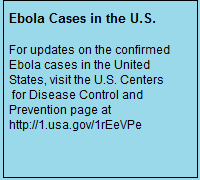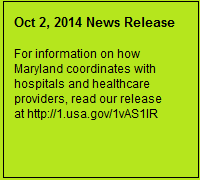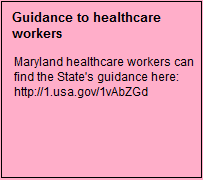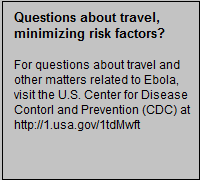Ebola Virus
Ebola virus disease (EVD) is a severe, often fatal, viral disease. Currently, there are Ebola outbreaks in the Western African nations of Guinea and Sierra Leone. This page is to familiarize Marylanders with facts about the virus and inform them on the steps taken by the State of Maryland to protect public health.
.jpg) To date, there have been no cases of the disease acquired in Maryland.
To date, there have been no cases of the disease acquired in Maryland.
Liberia Update:
On May 9, 2015, the World Health Organization declared the end of the Ebola outbreak in Liberia, and on May 13, 2015, the Centers for Disease Control and Prevention (CDC) changed the classification for Liberia to “a country with former widespread transmission and current, established control measures.” As of June 17, 2015, travelers coming to the United States from Liberia will continue to be screened on entry, however, because the Ebola outbreak in Liberia is now over, CDC no longer recommends active monitoring for these travelers unless they also had recent travel to Guinea or Sierra Leone. Persons arriving from Liberia who had not also been in Sierra Leone or Guinea are instead now asked to watch their health, contact a health care provider if they develop new symptoms, and to report the recent travel.
What are the symptoms of Ebola?
Ebola symptoms usually include fever. Other symptoms may include headache, diarrhea, vomiting, weakness, joint and muscle aches, stomach pain, lack of appetite and bleeding. The symptoms can be similar to other, more common, infections. Symptoms appear 2-21 days after exposure to the virus, but most commonly occur 8-10 days after exposure.
How is Ebola spread? 
Individuals who do not have a fever are not contagious and cannot transmit the disease to another person. The Ebola virus is transmitted through direct contact with the blood or body fluids of an infected person with symptoms or through exposure to objects (such as needles) contaminated by infected body fluids. Transmission can also occur from directly handling bats, rodents or primates in areas where Ebola occurs.
How Ebola is Spread
Who is at risk for Ebola?
Individuals who have recently been in a country with known Ebola, and who also have had:
 Contact with blood or other body fluids of a patient or dead body known to have or suspected to have Ebola, or
Contact with blood or other body fluids of a patient or dead body known to have or suspected to have Ebola, or
- Direct handling of bats, rodents or primates.
If someone has symptoms of Ebola and a possible exposure, that person should see a healthcare provider.
What is the treatment for Ebola?
There is no specific treatment for Ebola; treatment is limited to close monitoring and supportive
What is the risk of Ebola in Maryland?
 A number of actions protect Marylanders from Ebola:
A number of actions protect Marylanders from Ebola:
- First, there are restrictions on travel for individuals in affected nations who are ill.
- Second, there are efforts to screen passengers upon arrival in the United States.
- Third, our health care system can identify potential cases, isolate the individuals, and perform testing.
- Fourth, if there is a case in Maryland, hospitals can isolate the ill person and provide supportive care that may be lifesaving. DHMH will provide extra support to hospitals to protect the safety of our healthcare workers.
- Fifth, our public health system can track down contacts of cases and prevent further spread.
- Sixth, DHMH is monitoring emergency departments and working closely with hospitals and the CDC.
Because of these steps -- while it is possible that additional cases might appear in the United States, including Maryland -- it is very unlikely that there will be a significant outbreak here. Strict adherence to infection control practices prevents the spread of the virus in health care settings. DHMH will continue to work closely with leaders in infection control and CDC to support health care workers.
What is DHMH doing?
DHMH is monitoring the national and global situation and is in frequent communication with the CDC. DHMH is conducting disease surveillance and regularly communicates with and distributes guidance to Maryland hospitals and healthcare providers. DHMH works with health care providers and local health departments to quickly investigate reports of possible Ebola infections.
 In the event that a Maryland high-risk patient [someone who displayed symptoms and also had traveled to a West African nation where the Ebola outbreak is occurring or also had come into contact with the body fluids of an infected person] required testing, DHMH's lab (working in conjunction with the CDC's lab) would test specimens from that patient. In the event that both the CDC and DHMH labs returned a result confirming an Ebola infection, we would share that information with the public.
In the event that a Maryland high-risk patient [someone who displayed symptoms and also had traveled to a West African nation where the Ebola outbreak is occurring or also had come into contact with the body fluids of an infected person] required testing, DHMH's lab (working in conjunction with the CDC's lab) would test specimens from that patient. In the event that both the CDC and DHMH labs returned a result confirming an Ebola infection, we would share that information with the public.
Where can I learn more?
For the most current information regarding Ebola and outbreaks caused by Ebola, visit http://www.cdc.gov/vhf/ebola/
Download the DHMH Ebola General Fact Sheet

